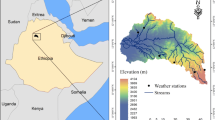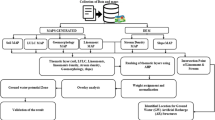Abstract
Identifying and visualizing groundwater depletion zonation is crucial for the scientific management of precious groundwater resources. Therefore, the main objective of this present study is to delineate groundwater depletion zonation (GDZ) using Technique for Order Preference by Similarity to an Ideal Solution (TOPSIS) integrated with GIS. The 13 relevant groundwater depletion parameters, i.e., NDBI, GMIS, groundwater trend and magnitudes, cropping intensity, irrigated area, population density, RAI in wet and dry seasons, and VCI were considered. This study also evaluated rainfall and groundwater trends and magnitudes using non-parametric Mann–Kendall (MK) and Sen’s slope (Q) estimator tests. From the MK result, groundwater trend in wet season ranges −4.11 to 3.05 and dry season ranges −2.24 to 3.28, whereas Sen’s slope in wet season −0.11 to 0.07 and dry season −0.11 to 0.39. The groundwater depletion zonation showed that 23.09, 49.90, 19.02, 793 and 0.06 areas were delineated as very low, low, medium, high, and very high susceptibility zones. Results also showed that middle portions of this district face high to very high groundwater depletion. So, a proper sustainable groundwater management plan is needed to replenish this precious natural resource.
Access this chapter
Tax calculation will be finalised at checkout
Purchases are for personal use only
Similar content being viewed by others
References
Aksoy S, Haralick RM (2001) Feature normalization and likelihood-based similarity measures for image retrieval. Pattern Recogn Lett 22(5):563–582
Al-Abadi AM, Ghalib HB, Al-Mohammdawi JA (2020) Delineation of Groundwater Recharge Zones in Ali Al-Gharbi District, Southern Iraq Using Multi-criteria Decision-making Model and GIS. J Geovisualization Spat Anal 4(1):1–12.https://doi.org/10.1007/s41651-020-00054-7
Al-Juaidi AE, Nassar AM, Al-Juaidi OE (2018) Evaluation of flood susceptibility mapping using logistic regression and GIS conditioning factors. Arab J Geosci 11(24):1–10
Allen RG, Pereira LS, Raes D, Smith M (1998) Crop evapotranspiration guidlines for computing crop water requirments. FAO irrigation and drainage paper 56. Food and Agriculture Organization, Rome
Allen RG, Pereira LS, Raes D, Smith M (n.d.) https://figshare.com. Retrieved from https://figshare.com/articles/dataset/Global_Aridity_Index_and_Potential_Evapotranspiration_ET0_Climate_Database_v2/7504448
Arabameri A, Rezaei K, Cerda A, Lombardo L, Rodrigo-Comino J (2019) GIS-based groundwater potential mapping in Shahroud plain, Iran: a comparison among statistical (bivariate and multivariate), data mining and MCDM approaches. Sci Total Environ 658:160–177. https://doi.org/10.1016/j.scitotenv.2018.12.115
Ashoka A, Gleeson T, Wada Y, Mishra V (2017) Relative contribution of monsoon precipitation and pumping to changes in groundwater storage in India. Nat Geosci 10:117–190
Basak A, Das J, Rahman ATMS, Pham QB (2021) An integrated approach for delineating and characterizing groundwater depletion hotspots in a coastal state of India. J Geol Soc India 97:1429–1440. https://doi.org/10.1007/s12594-021-1883-z
Bhanja S, Mukhrjee A, Saha D, Velicogna I, Famiglietti J (2016) Validation of grace based groundwater storage anomaly using in-situ groundwater level measurment in India. J Hydrol:729–738
Brown B, Nuberg I, Llewellyn R (2017) Negative evaluation of conservation agriculture: perspectives from African smallholder farmers. Int J Agric Sustain 15(4):467–481
CGWB (n.d.) Dynamic groundwater resource of India (as on March, 2009, CGWB, New delhi), 2011
Choudhury M, Jyethi DS, Dutta J, Purkayastha SP, Deb D, Das R, Bhattacharyya D (2021) Investigation of groundwater and soil quality near to a municipal waste disposal site in Silchar, Assam, India. Int J Energy Water Resour. https://doi.org/10.1007/s42108-021-00117-5
Chung ES, Abdulai PJ, Park H, Kim Y, Ahn SR, Kim SJ (2017) Multicriteria assessment of spatial robust water resource vulnerability using the TOPSIS method coupled with objective and subjective weights in the Han river basin. Sustainability (Switzerland) 9(1):29. https://doi.org/10.3390/su9010029
Deering DW (1975) Measuring “forage production” of grazing units from Landsat MSS data. In: Proceedings of the tenth international symposium of remote sensing of the environment, pp 1169–1198
Das J, Bhattacharya S (2018). Trend analysis of long-term climate parameter in Dinhata of Koch Bihar district, West Bengal. Spatial Inf Res:1–10
Das J, Mandal T, Saha P (2019) Spatial-temporal trend and change point detection of winter tempreture of North Bengal, India. Spatial Inf Res:411–424
Das J, Mandal T, Rahman AS, Saha P (2021) Spatio-temporal characterization of rainfall in Bangladesh: an innovative trend and discrete wavelet transformation approaches. Theoret Appl Climatol 143(3):1557–1579. https://doi.org/10.1007/s00704-020-03508-6
Deshmukh M, Tanaji VS (2017) Cropping intensity Index and irrigation intensity in India. North Asian Int Res J Soc Sci Human 3(2)
Fick SE, Hijmans RJ (n.d.) Worldclim 2: new 1-km spatial resolution climate surface for global land areas. Int J Climatol
Gain AK, Giupponi C, Renaud FG (2012) Climate change adaptation and vulnerability assessment of water resources systems in developing countries: a generalized framework and a feasibility study in Bangladesh. Water 4(2):345–346. https://doi.org/10.3390/w4020345
Hora T, Shrinivasan V, Basu N (2019) The groundwater recovery paradox in south India. Geophys Res Lett
Joerin F, Thériault M, Musy A (2001) Using GIS and outranking multicriteria analysis for land-use suitability assessment. Int J Geogr Inf Sci 15(2):153–174
Kendall MG (1975) Rank correlation methods. Griffin London United Kingdom
Keyantash J, Dracup JA (2002) The quantification of drought: an evaluation of drought indices. Bull Am Meteor Soc 83(8):1167–1180
Khansalari S, Raziei T, Mohebalhojeh AR, Ahmadi-Givi F (2018) Moderate to heavy cold-weather precipitation occurrences in Tehran and the associated circulation types. Theoret Appl Climatol 131(3):985–1003
Mandal T, Saha S, Das J, Sarkar A (2021). Groundwater depletion susceptibility zonation using TOPSIS model in Bhagirathi river basin, India. Model Earth Syst Environ:1–21
Mann H (1945) Non parametric tests against trend. Econometrica 13:245–259
Mukherjee P, Singh CK (2012) Delineation of groundwater potential zones in arid region of India—a remote sensing and GIS approach. Water Resour Manag 26(9):2643–2672. https://doi.org/10.1007/s11269-012-0038-9
Pearson E, Hartley H (1966) Biometrika tables for statisticians, vol. 1, 3rd ed. Cambridge University Press
Pettorelli N, Vik JO, Mysterud A, Gaillard JM, Tucker CJ, Stenseth NC (2005) Using the satellite-derived NDVI to assess ecological responses to environmental change. Trends Ecol Evol 20(9):503–510
Raziei T (2021) Revisiting the rainfall anomaly index to serve as a simplified standardized precipitation index. J Hydrol 602:126761
Sahoo S, Chakrabotry S, Pham QB, Sharifi E, Saad SS, Matej V et al (2021) Recognition of district-wise groundwaterstress zones using the GLDAS-2 cathcment land surface model during lean season in the Indian state of West bengal. Springer Acta Geophysica
Sen P (1968) Estimate of the regression coefficient based on Kendall’s tau. J Am Stat Asso 63:1379–1389
Shao G, Guan Y, Zhang D, Yu B, Zhu J (2018) The impacts of climate variability and land use change on streamflow in the Hailiutu river basin. Water 10(6):814. https://doi.org/10.3390/w10060814
Steven MQ, Srinivasan G (2009) Evaluting the utility of the vegetation condition index (VCI) for monitoring meterological drough in Texas. Elsevier
Swain S, Verma M, Verma MK (2015) Statistical trend analysis of monthly rainfall for Raipur District, Chhattisgarh. Int J Adv Eng Res Studi/IV/II/Jan–March, 87, 89
Tek BK (2018) NDvi, NDBi and NDWI calculation using Landsat 7, 8. Researchget, 1–7
UNEP (1997) World atlas of desertification. United Nations Environment programme
Van Rooy MP (1965) A rainfall anomally index independent of time and space, Notos
Walter I et al (2000) ASCE’s standardized refrence evapotranspiration equation. In: Proceedings of 4th national irrigation symposium, ASAE, Phoenix, A.Z
Wang Y, Qiu M, Shi L, Xu D, Liu T, Qu X (2019) A GIS-based model of potential groundwater yield zonation for a sandstone aquifer based on the EWM and TOPSIS methods. In: IMWA “Mine water: technological and ecological challenges”, pp 387–393
Zolekar RB, Bhagat VS (2015) Multi-criteria land suitability analysis for agriculture in hilly zone: remote sensing and GIS approach. Comput Electron Agric 118:300–321
Author information
Authors and Affiliations
Corresponding author
Editor information
Editors and Affiliations
Rights and permissions
Copyright information
© 2023 The Author(s), under exclusive license to Springer Nature Switzerland AG
About this chapter
Cite this chapter
Gupta, P., Tignath, S., Kathal, D., Choudhury, S., Mukherjee, K., Das, J. (2023). Groundwater Depletion Zonation Using Geospatial Technique and TOPSIS in Raipur District, Chhattisgarh, India. In: Das, J., Bhattacharya, S.K. (eds) Monitoring and Managing Multi-hazards. GIScience and Geo-environmental Modelling. Springer, Cham. https://doi.org/10.1007/978-3-031-15377-8_16
Download citation
DOI: https://doi.org/10.1007/978-3-031-15377-8_16
Published:
Publisher Name: Springer, Cham
Print ISBN: 978-3-031-15376-1
Online ISBN: 978-3-031-15377-8
eBook Packages: Earth and Environmental ScienceEarth and Environmental Science (R0)




